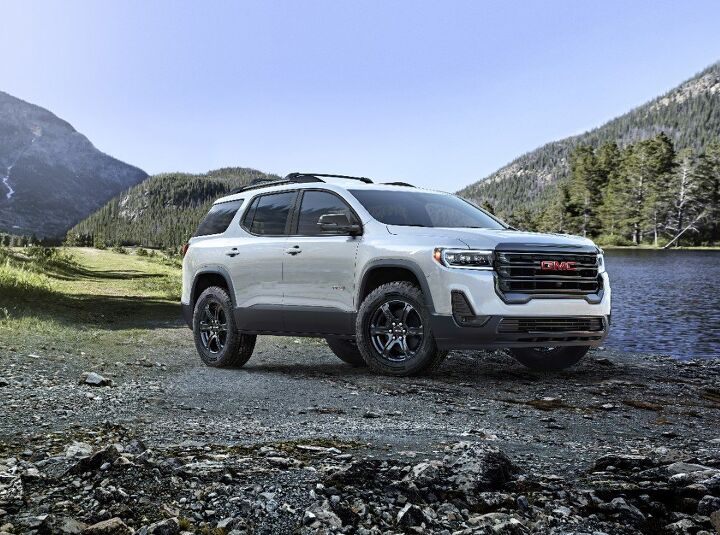GMC: Moving From the Middle?

GMC’s an interesting brand. Free of cars from the outset (Sprint/Cabalero notwithstanding), General Motors’ truck brand seems well positioned to turn America’s unquenchable thirst for trucks and utility vehicles into big, big bucks.
For the most part, it has, yet glaring shafts of white space remain in the brand’s lineup. Time for a little rearranging?
Automotive News‘ product pipeline provides a potential window into an automaker’s future, condensing down-low scuttlebutt, corporate whispers, and all other info into a likely product plan. The outlet recently focused on GM, and one thing stood out.
Does everyone recall the Acadia? The former full-size(ish) crossover that went midsize, even as the nameplates that once kept it company remained on the big side of the spectrum? Looks like it’s not staying put.
Refreshed in a questionable manner (in this writer’s opinion) for 2020, the downsized Acadia first came onto the scene in the middle of 2016, positioned above the soon-to-be-downsized (for MY2018) Terrain. GM soon added the Chevrolet Blazer as a two-row midsize option. While the two CUVs share a platform, the Acadia offers seating for up to 7.
That left the Buick Enclave and Chevrolet Traverse as the topmost rung of the GM crossover ladder. However, AN claims the Acadia’s trajectory will be boomerang-like, with the model returning to its former home in the near future.
Expected to see a redesign in 2024, the Acadia “will move to a larger platform to become the size of a Chevy Traverse and Buick Enclave, as it was in the previous generation,” the outlet wrote. At the bottom of GMC’s product range, a long-awaited subcompact crossover (Granite?) is believed to arrive in about a year.
While the move would stand to make GMC more money on both the high and low end of the lineup, helped along by a new Yukon for ’21, it would also leave the brand with a sizable gap in the middle. Is that space GMC needs to occupy? Depends who you ask.
The Acadia reached new sales heights in 2017, selling more than 111,000 units in the U.S., though the subsequent two years saw sales fall to basically what they were in the two years preceding the model’s size change. The larger Traverse has only seen its fortunes rise over the past half-decade, with the model posting more than 147,000 sales last year. Maybe the Acadia name would be better served affixed to a larger vehicle.
Someone prone to conspiracy theories would suggest that the hollowing out of the middle of GMC’s lineup is all about creating space for an off-road-focused SUV, but there’s no evidence that this is the case. For all we know, the Ford Bronco and Jeep Wrangler will remain the only two contenders in the ring.
[Image: General Motors]

More by Steph Willems
Latest Car Reviews
Read moreLatest Product Reviews
Read moreRecent Comments
- ToolGuy "I have my stance -- I won't prejudice the commentariat by sharing it."• Like Tim, I have my opinion and it is perfect and above reproach (as long as I keep it to myself). I would hate to share it with the world and risk having someone critique it. LOL.
- SCE to AUX Sure, give them everything they want, and more. Let them decide how long they keep their jobs and their plant, until both go away.
- SCE to AUX Range only matters if you need more of it - just like towing capacity in trucks.I have a short-range EV and still manage to put 1000 miles/month on it, because the car is perfectly suited to my use case.There is no such thing as one-size-fits all with vehicles.
- Doug brockman There will be many many people living in apartments without dedicated charging facilities in future who will need personal vehicles to get to work and school and for whom mass transit will be an annoying inconvenience
- Jeff Self driving cars are not ready for prime time.



































Comments
Join the conversation
Very curious when reading this that GMC will finally get a subcompact model for 2022, but will it be something better than the Encore GX? I feel like GMCs version should use the D2XU platform to make it wider and longer than the other subcompacts from GM. GMC should aim the "Granite" squarely at the Countryman with style and customization as the core of the model. The 2.0T should be the smallest engine for any GMC model with the 2.7T as the upgrade. These models are "professional grade" and should have more features akin to Cadillac than Chevy with totally unique interiors. Hopefully GM has been listening to all the critics on their latest products and push the boundaries more.
I thought GMC made work trucks, not luxury vehicles. Isn't their tagline, "We are professional grade".